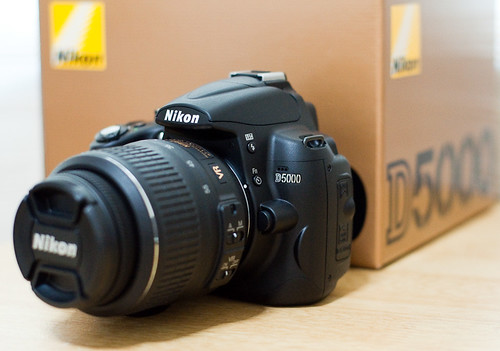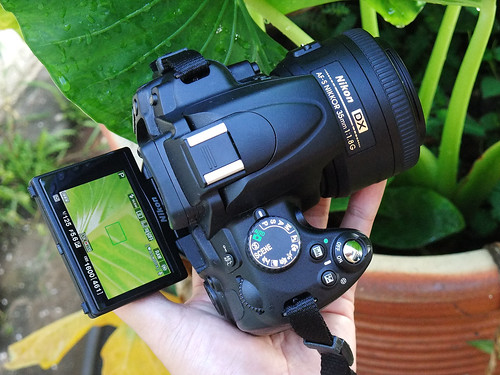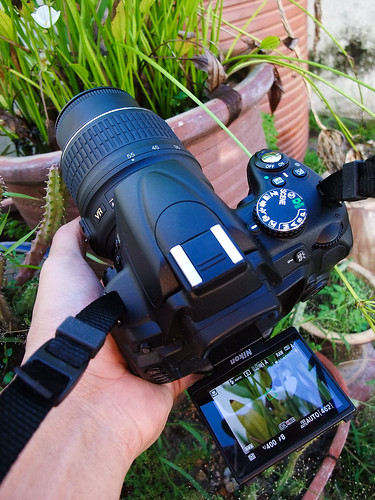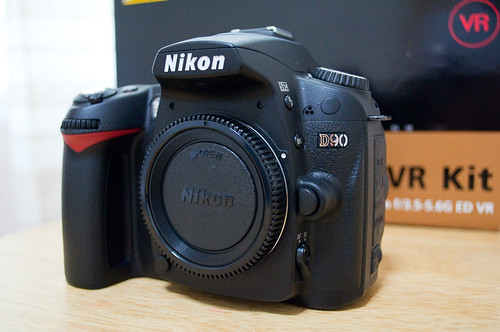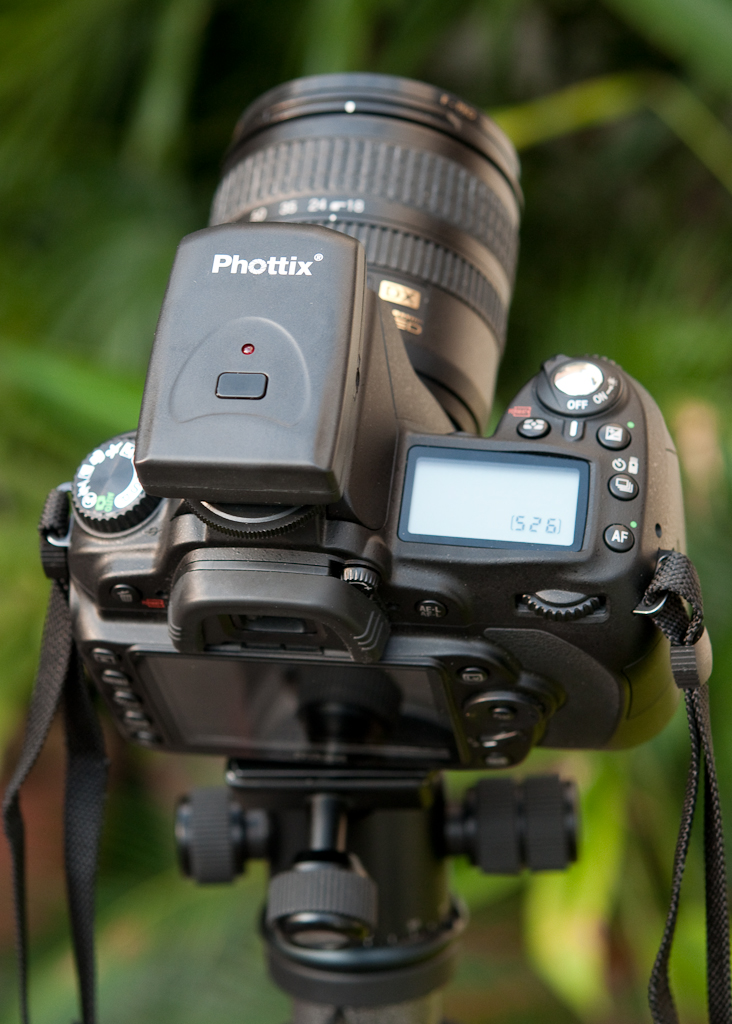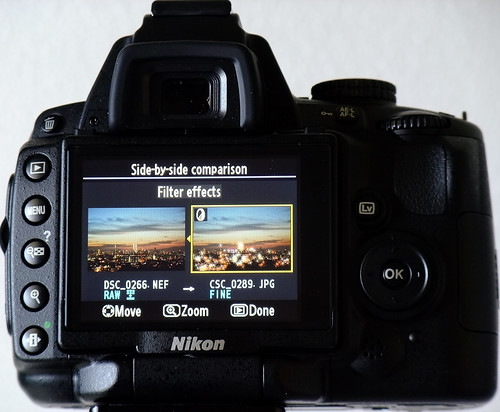Which camera would you choose, and why — the Nikon D90 or Nikon D5000 digital SLR camera?
What are the pros and cons of each DSLR?
In this post, I attempt to compare and summarize the benefits of, and the differences between these two digital SLR cameras from Nikon and hopefully, this will help those who are researching whether to get the D90 or the D5000.
In terms of resolution, both cameras have the same 12.3 MP (Megapixels, or million pixels), so you’ll have to make the final decision on which camera to buy based on the other comparison factors.
For a quick side-by-side comparison of both cameras, see this page on DPReview. You might also want to download and read the Digital SLR Comparison Chart from Nikon (right-click to download the 213 KB Adobe Acrobat PDF document to your hard drive) for a more complete look at the specifications of both cameras.
To understand the functionality, features and operation of both cameras, refer to the Nikon D5000 Manual and Nikon D90 User Manual posts for download instructions.
Nikon D5000 Advantages
Slightly lighter
If you plan on doing lots of hiking or traveling where you might want to keep the weight of your photographic equipment to an absolute minimum, then the D5000 is the logical choice as it is about 62 g / 2.2 oz lighter than the D90.
Note though, that the D5000 is slightly larger than the D90 in terms of cubic volume.
Let’s look at some relevant figures.
Dimensions
Nikon D5000: 127 x 104 x 80 mm (5 x 4.1 x 3.2 in). Volume is approximately 65.6 cubic inches.
Nikon D90: 132 x 103 x 77 mm (5.2 x 4.1 x 3 in). Volume is approximately 63.96 cubic inches.
Weight
Nikon D5000: Approx. 562 g (19.8 oz) without battery, memory card or monitor cover.
Nikon D90: Approx. 624 g (22 oz) without battery, memory card or monitor cover.
The difference in weight increases to 113 g / 4 oz when we factor the battery into the equation, as the D90 uses the slightly larger and heavier EN-EL3e, while the D5000 uses the EN-EL9a on the D5000.
Nikon D5000 weight (inc. a single battery): 590 g (20.8 oz)
Nikon D90 weight (inc. a single battery): 703 g (24.8 oz)
Susan, a.k.a “pupgirl” posts the following impressions after handling both cameras:
[…] I originally considered the D90 before buying a G1 and was disappointed that the D90 was bigger than the D40 or D60. I’ve handled both the D5000 and D90 and the D5000 absolutely is smaller and FEELS smaller much closer to the D40. I have medium-sized hands and the D5000 fits great.I did have to handle it to see though as the specs don’t convey the difference, to me.
Exquisite shutter / mirror slap sound
Shooting the D5000 means you’ll enjoy it’s quiet shutter / mirror action. The pitch is much lower than that on the D90, and very few would notice that you’ve even taken a shot.
I’ve taken photos of my children when they’re asleep. With the D5000 barely two feet away, the camera was so quiet that they did not even stir one bit.
Interval Timer (Intervalometer) Shooting
Time lapse photography is easy with the D5000, thanks to the availability of a built-in intervalometer.
Here’s a screen capture of the graphic on page 11 of DPReview’s D5000 review, which shows the menu item that is used to activate this feature.
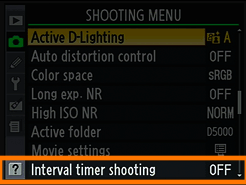
Nice to see Nikon including interval timer shooting capability on the Nikon D5000.
DCResource has more details on this feature:
Interval timer shooting – time-lapse mode
Start time (Now, set time)
Interval (1 sec – 24 hours)
* Number of intervals (1 – 999)
Nikon D90 owners would need to purchase third-party accessories such as the TR-M Timer Remote Control or the Opteka Timer Remote Control to enjoy similar functionality.
Simpler to use
Generally-speaking, the D5000 has less controls and settings to deal with than the D90. Psonicfan says:
I purchased the D5000 because it was lighter and more compact than the D90.The easy-to-use features on the D5000 makes it simple to go from point and shoot to a DLSR, and thus, it seemed the logical choice.
After using it for a couple of months and purchasing lenses that suit what I want it to do, I couldn’t be happier with both the quality of images and the ease of use.
I believe a LARGE amount of DLSR uses will never even scratch the surface in terms of what their DLSRs can actually do so the D90 may be be better suited to a more experienced user who understands DLSRs better.
For me, being a relative novice, I wanted the D5000, and the fact it shares the D90 sensor means I have yet to see that the D90 actually takes a better picture than the D5000.
It was the best money I spent and wouldn’t change my decision if I had my time again.
losthumans posts a long and thoughtful opinion on who the D5000 might be more suitable for:
A few months ago I was finally able to talk my wife into purchasing a DSLR, we had purchased 3 to 4 point-and-shoot cameras to photograph the family etc. over the last few years and were always fairly unhappy / barely satisfied with the results. A few friends started moving into the DSLR arena and once we learned that there were options that didn’t cost 1k+ we caught the bug.The D40 was our choice initially, we had read a few things about the great high ISO quality of Nikons and thought we were ready to make a purchase, then comes the D5000. For not much more we thought we could squeak into a better quality sensor and a more robust DSLR. The cost and perceived complexity of the d90 was just too much, but the D5000 seemed just about perfect. So we picked one up.
Yes there is a recall, join the wonderful world of electronics.
Yes the D90 has more features, better build, etc.
But, for the price, the D5000 is a great camera.
It’s a step up from the super duper entry level, but packs a serious bang for the buck.
The quality difference between this camera and our previous point and shoots is dramatic, ridiculously dramatic.
The shots of the kids are amazing, even when they are out of focus and grainy they are still better than the old shots we got.
Long story short, if you can’t afford or seem a bit put off by the upper models like the D90 but can squeak into that D5000 realm, go for it, you will not be sorry.
For 600-700 bucks you can get a camera that a couple years ago would have cost thousands.
Truly incredible.
Looking at the ROI, the difference between just getting into the DSLR world with a camera like the D5000 (or heck even the new D3000) is substantial.
Go for it, don’t wait, every day you save up for the bigger and better camera, is a day of potentially amazing and wonderful shots lost.
I’d also add that the D5000 has much more scene modes to make photography in various situations an easier process. I’ve extracted the list of such modes on both cameras from their respective user manuals below.
D5000 scene modes: portrait; landscape; child; sports; close up; night portrait; night landscape; party/indoor; beach/snow; sunset; dusk/dawn; pet portrait; candlelight; blossom; autumn colors; food; silhouette; high key; low key.
D90 scene modes: portrait; landscape; close-up; sports; night portrait.
Articulating LCD
Steve 316 explains how he uses the tilt-swivel LCD monitor on the D5000:
I was pleasantly surprised with the movable LCD. I have the 16-85 on my D5000 and that lens’s wide angle (24mm equivalent) is very effective just a few inches off the ground — gives you a fascinating foreground with sand dunes, river banks, forest moss, or whatever your shooting. Being able to tilt the screen means you don’t have to lie down or scrunch down quite as far to frame and take the photograph.Shooting swallows on on a beach cliff not long ago, I climbed up as far as I safely could. Then I was able to raise the camera over my head, clear the last rock outcropping, and get some swallows-in-the-nest photos that would have been impossible without the tiltable LCD.
So many photos are taken with or without tripod at about eye-level. I am finding the tiltable LCD is encouraging me to take lots more photos higher (over my head) and lower (near ground level) with more creativity and great results.
I have to agree with Steve 316 — the flip-out LCD, in conjunction with the LiveView feature, is definitely a great convenience when photographing low-lying subjects.
The articulating LCD was also one of the main reasons I switched from the D90 to the D5000. In my case, shooting video has become a much more comfortable affair since I can hold the camera at waist level with the LCD folded out, and follow my 4-year old kids as they run around.
Price
No comparison here, the D5000 is about $190 cheaper at the time of writing. The money saved can go towards purchasing additional accessories such as the Nikon SB-400 or SB-600 external Speedlight flash units, or a cheap but excellent lens such as the Nikon 50mm f/1.8D AF (note that this lens cannot autofocus on the D5000 — more on such lenses later).
Check Nikon D5000 Price Watch and Availability and Nikon D90 Price Watch for more information.
Nikon D90 Advantages
Autofocus motor built into the body
The D90 has an internal AF motor, which means it can autofocus with any AF lenses ever made by Nikon. The list includes some of the great classic AF-D lenses such as the Nikon 50mm f/1.8D AF (read my review on it) and Nikon 85mm f/1.4D AF.
The D5000 lacks such a motor, relying exclusively on the AF motor that’s built into the lens itself. You can still mount the older AF-D lenses on the D5000, but would have to manually focus them by turning the focusing ring on the lens barrel.
Note that all modern Nikon lenses, with the exception of the specialized tilt-shift optics, have a built-in motor (those that have the AF-S designation), and Nikon is working overtime to deliver many new glass, so this is no longer a serious issue.
When you purchase third-party lenses from Tamron, Sigma or Tokina, be sure that they come with a built-in AF motor.
Marginally superior burst speed
If high speed action photography is your thing, and you need to capture extremely quick sequences of photos in rapid succession, then you’d have to step up to Nikon’s professional-grade DSLR cameras such as the Nikon D300S which can shoot at speeds of up to 8 fps (frames per second).
Comparatively, the D90 and D5000 shoot only at 4.5 fps and 4 fps respectively, so, there is a slight burst advantage to the D90. Looked at in another way, the D90 allows you to capture 9 photos in 2 seconds, while you get 8 with the D5000 in the same time interval.
The D90 also lets you select a CH (Continuous High) or CL (Continuous Low) burst mode. For the CL mode, you can select burst speeds of 1, 2, 3 or 4 frames per second.
Built-in flash commander
The most glaring disadvantage on the D5000 in terms of feature differences is the inability to use its pop-up, internal flash as a controller / commander in wireless “Creative Lighting System” flash setups to trigger remote Nikon Speedlight flash guns such as the SB-600, SB-800 and SB-900.
When I had the D90, I used this feature mainly for macro shots, where I’d hold the SB-800 in my left hand and place the flash head near the subject, while triggering the flash with the internal flash on the camera, and get the full-benefit of i-TTL flash metering in the process.
Read the section on putting the SB-600 in remote mode to get an idea of how this feature is used. If you anticipate doing lots of off-camera, wireless flash photography, the D90 is the camera to get.
Better viewfinder
The viewfinder in the D90 uses a pentaprism while a pentamirror is used for the viewfinder in the D5000. Pentaprism viewfinders give a brighter and larger image compared to pentamirror types.
Viewfinder magnification is higher on the D90, 0.96x compared to only 0.78x for the D5000.
Coverage on the D90 is marginally better at 96% compared to 95% on the D5000.
For a really good read on viewfinders, please refer to this Luminous Landscape article.
A better viewfinder is critical if you’re going to be shooting lots of images over an extended period as this generally leads to less eye fatigue.
Fine tune optimal exposure
The D90 lets you change the exposure value selected by the camera.
Custom setting b4 in the D90’s menu allows you to apply a global +1 to –1 EV in steps of 1/6 EV to each of the D90’s metering modes. For instance, you can opt to adjust matrix metering by -1EV, spot metering +1EV, and leave center-weighted alone.
This setting is not available on the D5000.
The Control Panel
Found on the top right of the D90, this dedicated monochrome LCD screen offers a wealth of information on photographic and camera settings that makes it easier to determine at a glance whether the camera is optimally set up for the next shoot.
Nikon did not include such a panel on the D5000 in order to save space, so one must rely on the rear LCD panel which has to play double duty as an image preview screen.
More photos on a single charge
The D90 uses the slightly larger and heavier EN-EL3e battery which allows you to take up to 850 shots (CIPA Standard) on a full charge.
A full-charged EN-EL9a battery used in the D5000 lets you take 510 (CIPA Standard) pictures.
Can be used with a Nikon battery grip
If you’ll be shooting a lot of photos in portrait / vertical orientation and want to stick with Nikon products as much as possible, there’s the Nikon MB-D80 battery grip, which also has space for additional EN-EL3e batteries for extended shooting stints.
Nikon does not make a battery grip for the D5000, although there are numerous third-party solutions, which I’ll mention in a bit in the conclusions.
Nicer rear LCD
The rear LCD on the D90 is larger and has higher resolution than the one on the D5000.
The specs are: 3.0-inch, 921,000-dot screen on the D90, 2.7-inch, 230,000-dot screen on the D5000.
You would not notice what you’re missing unless you compare the both side-by-side. However, if you want the best possible preview image, then spring for the D90. Preview images on the D90 look almost like actual prints.
Additional points and links from an old blog post
Nikon D5000 vs Nikon D90, by Mike Kobal
Here’s a nice, side-by-side video tour of the differences between the Nikon D5000 and Nikon D90, done by Mike Kobal.
Side by side, Nikon D5000 vs Nikon D90 from Mike Kobal on Vimeo.
Handling a Nikon D5000 vs Nikon D90, from a lady’s point of view
The weight and dimension specifications seem to suggest that the Nikon D5000 is similar to the Nikon D90 in terms of bulk.
Susan, however, shares her impressions of the D5000:
… I originally considered the D90 before buying a G1 and was disappointed that the D90 was bigger than the D40 or D60. I’ve handled both the D5000 and D90 and the D5000 absolutely is smaller and FEELS smaller much closer to the 40. I have med sized hands and the D5000 fits great.I did have to handle it to see though as the specs don’t convey the difference, to me.
The “40” that Susan mentioned refers to the Nikon D40.
Some are OK with the D5000’s smaller viewfinder vs the D90’s
So, the viewfinder magnification on the Nikon D5000 is smaller and generally not as well-specified as the Nikon D90.
The viewfinder on the D5000: Pentamirror, 95% coverage, 0.78x magnification.
The viewfinder on the D90: Pentaprism, 96% coverage, 0.96x magnification.
And Sosumi says:
Of course, I’d rather have the best of both worlds, but I gladly sacrifice a bigger OVF for a swivel screen.In general I look first with my eyes what I want to shoot. The time I have my eye peeping thru the OVF is very short…
Makes sense.
I used to have a Nikon D70 for the longest time, and also used my brother-in-law’s Nikon D40 and D200, and D700, Nikon D3 and D3X that belonged to friends.
Having used so many different models of Nikon DSLR cameras with different viewfinder characteristics, I personally wouldn’t list the viewfinder size as a deal-breaker factor for me.
Whether you can work well with a camera’s feature set to produce the type of images you want is a far more important consideration.
Nikon D5000 has interval timer shooting
This is a screen capture of the graphic on page 11 of DPReview’s D5000 preview.

Nice to see Nikon including interval timer shooting capability on the Nikon D5000.
Interval timer shooting — time-lapse mode
* Start time (Now, set time)
* Interval (1 sec — 24 hours)
* Number of intervals (1 — 999)
But when can we D90 owners get our own intervalometer feature — firmware update, Nikon, please?
In the meantime, we’ll have to use gadgets like the Phottix Nikos to get our fix.
Nikon D5000 vs Nikon D90: Most glaring feature differences
On the subject of Nikon D5000 vs Nikon D90, the most glaring disadvantage on the D5000 in terms of feature differences is the inability to use its pop-up, internal flash as a controller / commander in wireless “Creative Lighting System” flash setups with compatible Nikon Speedlight flash guns (SB-600, SB-700 SB-800, SB-900).
I’ve been reliant on this feature ever since the days of the Nikon D70. I use it mainly for macro shots, where I’ll hold my SB-800 in my left hand and place the flash head near the subject, while triggering the flash with the internal flash on the camera, and get the full-benefit of i-TTL flash metering in the process.
I do like the idea of the D5000’s tilt-swivel LCD monitor though. I believe this most closely approximates the shooting experience I’ve had with the Nikon Coolpix 4500, and it’ll make it so much easier to shoot stuff with the camera close to the ground.
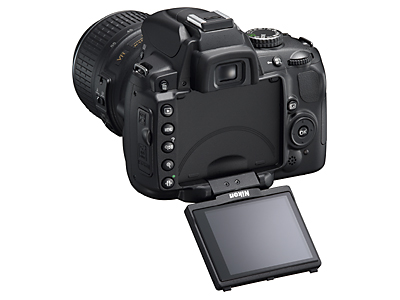
At the time of writing, the D5000 is also the first Nikon DSLR to feature a “Quiet” mode, where the shutter doesn’t get re-cocked until the shutter button is released. Based on my understanding of page 7 of DPReview’s D5000 preview, the Quiet mode is available as one of the shooting mode options (Single, Continuous, Self-timer, Remote + timer, Remote, Quiet mode).
Conclusions
Some more food for thought
Susan a.k.a. “pupgirl”, who initially opted for the D5000 based on its slightly lighter weight and smaller size, ended up selling it for the D90 instead. She clearly prefers the D90, as the following posts (quoted and re-worded for clarity) show.
I agree … bought the D5000 […] to save some weight. Having checked out the D90 more, it does (for me) feel more balanced.The D5000 feels a bit cramped with my medium-sized hands. The D90’s viewfinder is larger and brighter, has dedicated buttons vs. having to hunt through menus on the LCD on the D5000.
The D90 also has the better LCD.
There isn’t as much weight difference as I thought there would be initially. At least I have some great lenses to use on the D90 body I’ll be getting when I can.
I traded the D5000 kit (sent in once for recall) toward a D90 body.Viewfinder and LCD on the D90 are bigger and brighter.
The D90 has dedicated buttons rather than having to go through menus as you’d have to do on the D5000.
I don’t find weight difference significant for me, my hands were a little cramped on the D5000.
The D90 is faster, and has more lens and flash options.
I agree that the use of the flip screen on the D5000 for self portraits is position-limited when used on a tripod.
Doctortt used both cameras, and ended up preferring and choosing the D90:
- The D90 produces brighter photos.
- The D90 handles better, and balances better with a variety of lenses, thus making it easier to take sharper photos. It’s as if Doctortt’s photo-taking skill improved overnight/
- Immediate access to key camera settings such as ISO and WB (White Balance) via buttons on the D90 makes for a much smoother photo-taking process.
- The articulating LCD screen on the D5000 makes taking photos and video at challenging angles easier. However, the screen on the D90 is larger and has better resolution.
Regarding the slight differences in metering, Doctortt adds:
Again, I am not saying D90 is better than D5000. I just want to defend my own decision that D90 better fits my need. I also want to make sure the perspective buyers understand that there is no MAJOR exposure issue per my own experience. Their decision should be based on other factors. If they can’t live with this potential exposure issue occasionally, they should move on.
Ben Hermann recommends using a third-party battery grip to improve the handling on the D5000.
Moonman52’s opinion on the D5000:
I bought my D5000 the first day they were available and think it is a great camera. This was my seventh DSLR and the best one yet.I have it matched up with the 16-85 VR which makes a killer package. I shoot mostly landscapes and though I could afford the D90 or D300 chose the D5000 over both because I wanted a lighter more compact body and prefer the articulating LCD screen for landscape work using a tripod.
Image quality is at least as good as that of the D90 and I have not had any issues of any kind with the camera under heavy usage.
harold1968 ended up getting the D5000, and says:
In terms of the D90 vs the D5000, I will probably get super-flamed for saying this, but for the extra money and weight you are paying for a slightly better battery, better screen and more buttons.The last one, more buttons, is actually the main advantage. At first the D5000 “all on screen” menu was a bit of a shock, but after using Olympus for a bit I really saw the advantage of this. I think the D5000 would be perfect if it had a few more buttons, mainly ISO and Metering, but each to his own.
Lastly, the D5000 felt right in my hand, the D90’s grip was just a bit too bulky, but I guess some other folk will like it more.
Anyway, the pictures, stunning. The ISO performance is almost on par with my Canon 5D, and thats saying something!
ru1thirst returned his D5000 and exchanged it for the D90:
I’ve had both.After the 2nd recall on the D5000, I went back to store and got full credit for purchase towards the D90.
Every day I find a little something here and there that I like over the D5000 that I had.
Now as far as picture quality, I haven’t run across anything that stood out but the overall easy of use, the viewfinder, the bigger & brighter screen and the biggie is the 2 LCD screens to view all info and how easy it is to adjust settings with the buttons vs menu on the D5000.
The additional weight is next to nothing. At least to me.
Don’t get me wrong, I really liked the D5000 for its flip out screen but when I purchased a Manfrotto tripod, I couldn’t use it the way I had enjoyed it because of the tripod mount.
Long story short, in my situation, the D90 after the 2nd recall of my D5000 was a no brainer. Sometimes it worth the little extra money to think “long term”.
My own advice is as follows.
Choose the D90 if you shoot a lot of events or weddings where you need quick access to important camera settings and need a way to change the values quickly. For instance, ISO and Metering modes. The D90’s front dial allows quick tuning of the WB (White Balance) along the amber-blue axis, something the D5000 CANNOT do without having to dive into the menu.
If you prefer a more unhurried and simplified approach to photography, the D5000 with its quieter shutter would probably appeal more to you. The multitude of scene modes (complete with short, on-screen tips to guide you on when to use a particular mode) is also a big help. Also, the flip out LCD is a big, big help if you intend to shoot a lot of video of kids or pets, or need to take shots from a low angle.
Good luck with your decision!
Related
Nikon D90 — Main page
